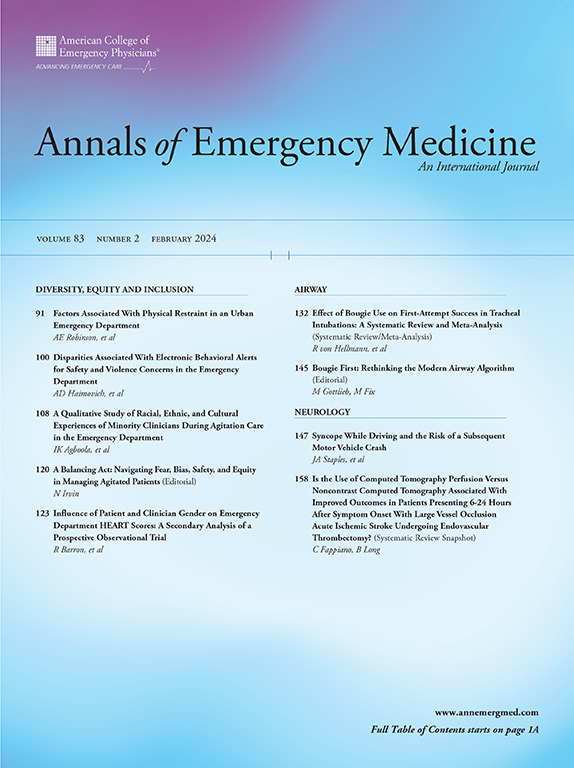检验西班牙裔或拉丁裔二元种族变量与原籍国之间的一致性。
IF 5
1区 医学
Q1 EMERGENCY MEDICINE
引用次数: 0
摘要
研究目的人口统计数据对于识别和解决差异至关重要,但受到数据分类问题的挑战,特别是对于西班牙裔或拉丁裔患者。种族数据通常通过(1)西班牙裔或拉丁裔二元反应和/或(2)原产国清单收集;然而,对于“西班牙裔”和“拉丁裔”这两个词代表哪些人群,目前还没有达成共识。我们的目的是检查通常收集的二元种族变量和基于原产国的定义之间的一致性。方法对某地区卫生保健系统患者(2021年1月1日至2023年11月16日)进行横断面研究。主要结果是西班牙裔或拉丁裔二元种族和原籍国之间的一致性。考虑到西班牙裔或拉丁裔所代表的国家的差异,我们使用了多种定义,包括来自美国管理和预算办公室的定义。结果在确定的2,919,810例患者中,83.1%完成了西班牙裔或拉丁裔二元种族问题的回答,75.1%完成了原籍国种族变量的回答。使用二元变量,241,391人被记录为西班牙裔或拉丁裔,其中169,731人(70%)具有管理和预算办公室定义中确定的原籍国。将巴西、海地、伯利兹和圭亚那纳入扩展定义后,一致性增加(n=176,048; 73%)。结论:我们的研究结果强调了仅使用西班牙裔或拉丁裔二元种族变量的局限性,特别是它可能导致低估。努力改善数据质量和细微差别,特别是在急诊科,是至关重要的,因为对差异的不准确评估可能导致干预措施的错误方向,并最终失去减少疾病负担的机会。本文章由计算机程序翻译,如有差异,请以英文原文为准。
Examining Agreement Between Binary Hispanic or Latino Ethnicity Variable With Country of Origin.
STUDY OBJECTIVES
Demographic data are critical in identifying and addressing disparities but are challenged by data classification issues, particularly for Hispanic or Latino patients. Ethnicity data are typically collected through (1) binary Hispanic or Latino response and/or (2) country-of-origin checklist; however, there is no consensus on which populations are represented by the term Hispanic or Latino. Our objective was to examine the agreement between the commonly collected binary ethnicity variable and country-of-origin-based definitions.
METHODS
We conducted a cross-sectional study among patients in a regional health care system (January 1, 2021 to November 16, 2023). The primary outcome was agreement between the binary Hispanic or Latino ethnicity and country of origin. Given the variation in countries represented by the term Hispanic or Latino, we used multiple definitions including from the US Office of Management and Budget.
RESULTS
Among the 2,919,810 patients identified, 83.1% had completed responses to the binary Hispanic or Latino ethnicity question and 75.1% had completed responses to the country-of-origin ethnicity variable. Using the binary variable, 241,391 were documented as Hispanic or Latino and of these, 169,731 (70%) had countries of origin identified in the Office of Management and Budget definition. An expanded definition additionally including Brazil, Haiti, Belize, and Guyana had increased agreement (n=176,048; 73%).
CONCLUSION
Our findings highlight the limitations of using only the binary Hispanic or Latino ethnicity variable, specifically in that it may lead to underestimation. Efforts to improve data quality and nuance, particularly in the emergency department, are critical as inaccurate assessment of disparities may lead to misdirection of interventions, and, ultimately, missed opportunities to decrease disease burden.
求助全文
通过发布文献求助,成功后即可免费获取论文全文。
去求助
来源期刊

Annals of emergency medicine
医学-急救医学
CiteScore
8.30
自引率
4.80%
发文量
819
审稿时长
20 days
期刊介绍:
Annals of Emergency Medicine, the official journal of the American College of Emergency Physicians, is an international, peer-reviewed journal dedicated to improving the quality of care by publishing the highest quality science for emergency medicine and related medical specialties. Annals publishes original research, clinical reports, opinion, and educational information related to the practice, teaching, and research of emergency medicine. In addition to general emergency medicine topics, Annals regularly publishes articles on out-of-hospital emergency medical services, pediatric emergency medicine, injury and disease prevention, health policy and ethics, disaster management, toxicology, and related topics.
 求助内容:
求助内容: 应助结果提醒方式:
应助结果提醒方式:


